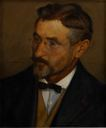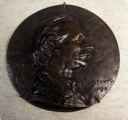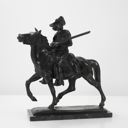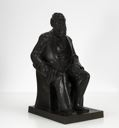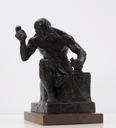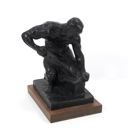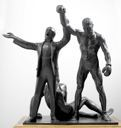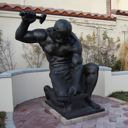Mahonri Mackintosh Young does not have an image.
Mahonri Mackintosh Young
Academie Julian sculpture
(Salt Lake City, Utah, 1877 - 1957, Norwalk, Connecticut)
Mahonri Young was born August 9, 1877, twenty days before the death of his grandfather, Brigham Young. Mahonri was the last grandchild born before Brigham's death. Legend has it that Brigham's last words were, "How is the new grandson?" Mahonri's Salt Lake high school experience was notably short...it lasted one day! He claimed he had "more important things to do." The more important things were repairing the family furniture and modeling figures. He was asked to mold the figure of a woman in butter for the creamery exhibit at the Utah State Fair. Completed and set in place, this work of art was as short lived as his high school education...someone forgot to shut the refrigerator door. However, in 1897, determined to satisfy his interest in art, Mahonri took a job at a bicycle repair and stationery shop in order to pay J. T. Harwood $2.50 a week for art lessons. Describing his study of art, Mahonri said, "I have always drawn, and since I was 18 have consciously tried to learn to draw. I have loved and studied all the great draftsmen, but have always gone to nature for my material. I have tried to make good drawings, not drawings that look good." Mahonri learned about the national art scene by reading Harpers and Scribners magazines. He worked in the Salt Lake Tribune's graphic department to earn enough money to study in New York City. In 1899, Young left Utah to attend the Art Student's League in New York City. Once there, Mahonri studied under the academic muralist Kenyon Cox, learning his approach to representational art. The New York experience was an eye opener for Salt Lake-born Mahonri. However, in 1901, Young was forced to return to Salt Lake City for financial reasons. Back in Utah, Young took a job with the Salt Lake Herald as a photo-engraver. His dream was to save enough money to travel to Paris. Once in Paris, Young's time was full of academic study. His real education, however, took place in the classrooms of nature, the studio, and the museum gallery. As he studied, Young became aware that he tended to paint linear action studies which related more to sculpture than to painting. For this reason, he shifted his study to sculpture, but throughout his career he was highly respected and won national prizes in watercolor, etching, and oil painting. Although Young experimented in contemporary approaches to form, he always returned to realistic expression to pursue his interest in capturing the human figure in motion. A stylizing Social Realist, Young was the winner of numerous awards and commissions on both local and national levels. During his life, he completed approximately 120 sculptures, 300 etchings, 1500 watercolors, more than 100 oil paintings, and thousands of sketches. Utah's most famous New York-based artist, Mahonri M. Young, spent the Great Depression teaching at the Art Student's League and doing work for the American Pavilion at the New York "World's Fair" of 1939. His Factory Worker and his Farm Worker were included in the decorative architecture of the pavilion. Young's Factory Worker ennobles the industrial laborer. Few other American sculptors have better represented the laborer in action; bone, brawn, and sweat. Young depicted the farmer, the blacksmith, and the scrub woman all as heroes of progress.
Academie Julian sculpture
(Salt Lake City, Utah, 1877 - 1957, Norwalk, Connecticut)
Mahonri Young was born August 9, 1877, twenty days before the death of his grandfather, Brigham Young. Mahonri was the last grandchild born before Brigham's death. Legend has it that Brigham's last words were, "How is the new grandson?" Mahonri's Salt Lake high school experience was notably short...it lasted one day! He claimed he had "more important things to do." The more important things were repairing the family furniture and modeling figures. He was asked to mold the figure of a woman in butter for the creamery exhibit at the Utah State Fair. Completed and set in place, this work of art was as short lived as his high school education...someone forgot to shut the refrigerator door. However, in 1897, determined to satisfy his interest in art, Mahonri took a job at a bicycle repair and stationery shop in order to pay J. T. Harwood $2.50 a week for art lessons. Describing his study of art, Mahonri said, "I have always drawn, and since I was 18 have consciously tried to learn to draw. I have loved and studied all the great draftsmen, but have always gone to nature for my material. I have tried to make good drawings, not drawings that look good." Mahonri learned about the national art scene by reading Harpers and Scribners magazines. He worked in the Salt Lake Tribune's graphic department to earn enough money to study in New York City. In 1899, Young left Utah to attend the Art Student's League in New York City. Once there, Mahonri studied under the academic muralist Kenyon Cox, learning his approach to representational art. The New York experience was an eye opener for Salt Lake-born Mahonri. However, in 1901, Young was forced to return to Salt Lake City for financial reasons. Back in Utah, Young took a job with the Salt Lake Herald as a photo-engraver. His dream was to save enough money to travel to Paris. Once in Paris, Young's time was full of academic study. His real education, however, took place in the classrooms of nature, the studio, and the museum gallery. As he studied, Young became aware that he tended to paint linear action studies which related more to sculpture than to painting. For this reason, he shifted his study to sculpture, but throughout his career he was highly respected and won national prizes in watercolor, etching, and oil painting. Although Young experimented in contemporary approaches to form, he always returned to realistic expression to pursue his interest in capturing the human figure in motion. A stylizing Social Realist, Young was the winner of numerous awards and commissions on both local and national levels. During his life, he completed approximately 120 sculptures, 300 etchings, 1500 watercolors, more than 100 oil paintings, and thousands of sketches. Utah's most famous New York-based artist, Mahonri M. Young, spent the Great Depression teaching at the Art Student's League and doing work for the American Pavilion at the New York "World's Fair" of 1939. His Factory Worker and his Farm Worker were included in the decorative architecture of the pavilion. Young's Factory Worker ennobles the industrial laborer. Few other American sculptors have better represented the laborer in action; bone, brawn, and sweat. Young depicted the farmer, the blacksmith, and the scrub woman all as heroes of progress.
Artist Objects
